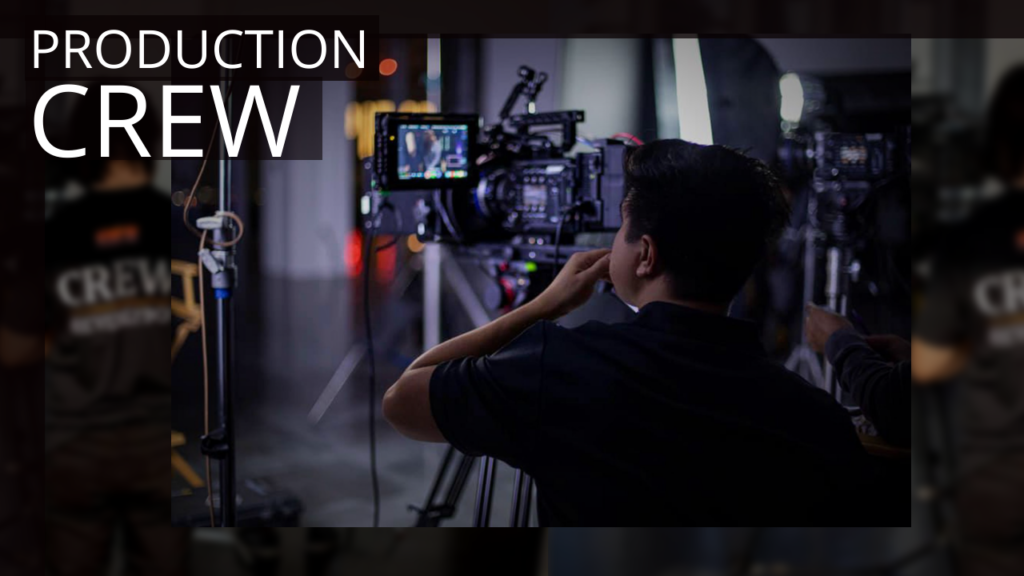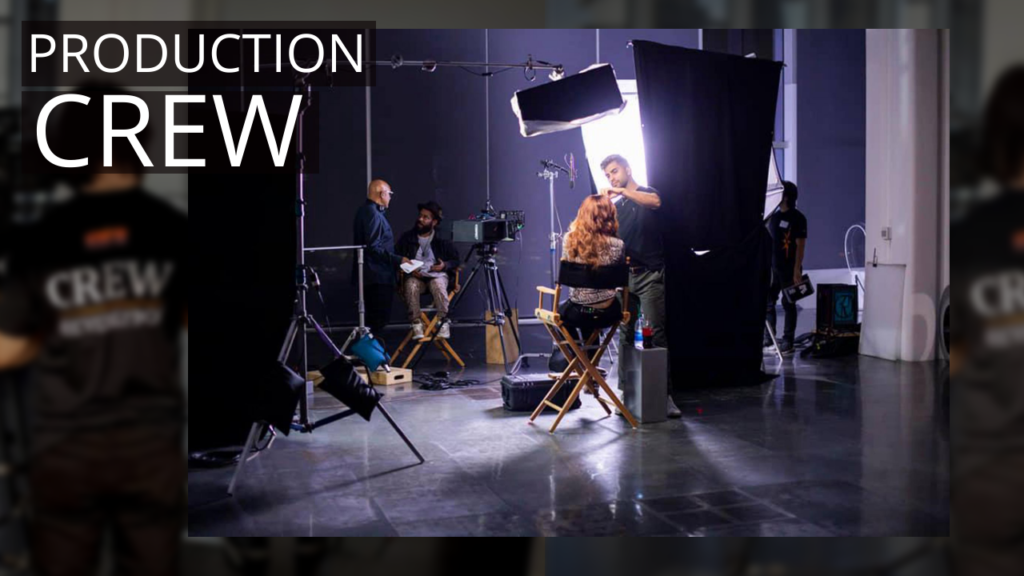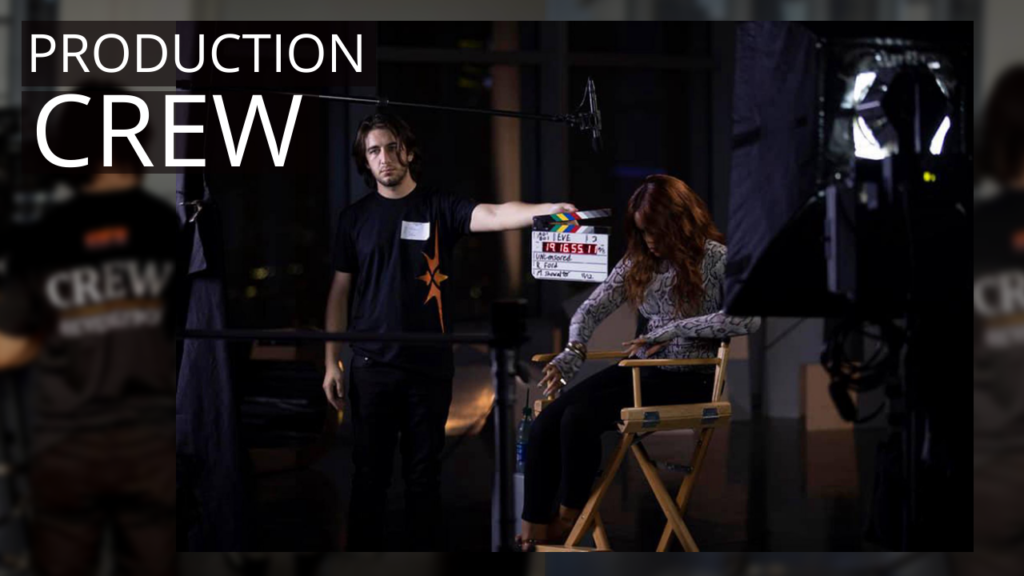Film Crew Positions
As you start on a film production, you’ll discover how many film crew positions are needed to fill different aspects of the production experience. Putting a professional film crew together is important when you start out on the filmmaking journey. It’s a marriage of technical and creative collaboration to create a stellar film. We’ve created a list of the people who are necessary for a larger budget production.
Even if you work on a small-scale project with a smaller crew, it’s still helpful to understand all the people that will go into creating the final product.
Who handles what in the process? You’ll figure this out during pre-production so you won’t have to struggle with it while filming.

Pre-production crew members
Story Editor
The story editor supervises the work of the story analysts for the studios. The analysts check out various screenplays, books, and more literary pieces looking for something that will work well for a movie. They will write a synopsis of the option they choose while the editor will review it and then pass it on to the “higher-ups” for possible development into a motion picture.
Writer
The term “Written By” that you see in the credits is a Writers Guild of America designation meaning “Original Story and Screenplay By.” The Writer will create and shape a story of their own, adapt a book into a screenplay, or work with a play to be used for the big screen. Scripts often go through many writers’ hands, which results in the Writer’s Guild of America determining who receives screen credit as the Writer.
Location Manager
The location manager will read the script to understand the type of locations needed for the film. They will also be the one that scouts for them. The location manager will visit different locations and take shots of them to later touch base with the director on the best setting for the film. Once locations are determined, the location manager also stays on top of the permits and permissions necessary for filming.
Dialogue Coach
The dialogue coach is key in helping actors learn the dialogue, accents, and more for the film.
Set Designer
The set designer will work with the art director on what the vision of the set is and then will go about designing and constructing it.
Art Director
The art director (also known as the production designer) is responsible for designing and supervising the creation of the movie sets. They have to be skilled in various design styles, as well as have an artistic vision, and know about architecture and interior design. They’ll work with the cinematographer to accomplish a great result for production.
Costume Designer
The costume designer will design the costumes needed for the cast. They create the final look of the characters and make sure that they use the styles worn during the era that the story refers to. Costume designers are key to the interpretation of the film’s characters.
There are other pre-production crew members, but this list includes some of the most prominent.

Production crew members
Unit Production Manager
The unit production manager (U.P.M.) stays on top of reports for the daily financial operation to a production manager. At times, the U.P.M. will look for locations as well and help with planning. When considering film crew positions, it is important to factor the UPM into the equation.
Line Producer
The line producer stays on top of the budget. They control things like the star’s payment and also daily expenses that come up with things like gear rentals and more. The production manager also shares his or her expenses to the line producer.
Production Manager
The production manager (P.M.) does business deals with crews and also sets up things that have to do with the technical aspect of production. This often includes getting the right gear for the project and taking care of lodging for cast and crew.
Director
The director takes on the creative part of the project, which typically involves hiring the cast, making sure the locations are ideal, and will also handle the planning of shots before the actual filming begins. During the shooting, the director will make sure that the crew and actors are doing their job right and will make sure that the movie is on time and budget. Oftentimes, the producer hires the director—unless they are the director.
Assistant Director
The assistant director (A.D., or First A.D. in larger productions) is there to make the whole process more effective. The A.D. helps prepare for shooting by separating the script into sections that can be shot in a single day, which helps to make the whole process run smoothly. During filming, the A.D. helps to act as a sort of manager for the project. They help to line up the best shots and keep things quiet during filming, as well as handle the extras that the film may call for. The assistant director tends to be a part of the Directors’ Guild of America.
Second Assistant Director
The second assistant director (second A.D.) works between the production manager and the first assistant director. The second A.D. handles things like call sheets, paperwork, scheduling, and actors’ timesheets and production reports. This person also helps the First A.D. with crowd control and extras.
Continuity Person
The continuity person makes sure embarrassing things don’t show up in the final film, such as actors wearing a piece of clothing that doesn’t show up in another shot in the same scene. They make sure to log how many times the scene is filmed, the length, and the actors that are in the shot, as well as where they’re standing, and any other important details—like the disappearing piece of clothing.

Cinematographer
The cinematographer, or director of photography (D.P./D.O.P.), helps with the feel and look of the film. The D.P. takes care of the lighting for every scene, helps to frame shots, picks the lenses, selects film stock, and makes sure that the final look is in line with the director’s artistic perspective. The cinematographer usually does not actually use the camera (this role belongs to the camera operator). What are the roles in a film crew? One of them will definitely be a cinematographer.
Gaffer
The gaffer is the top electrician on a set and takes care of the lighting according to what the cinematographer needs.
Camera Operator
The camera operator is a part of the actual camera crew and uses the camera as requested by the director and cinematographer. The camera operator gets the action in frame and responds to the action as it progresses.
Assistant Cameraman
Typically, there will be a first and second assistant cameraman. The first assistant cameraman stays on top of camera maintenance. He or she changes lenses, maintains focus during filming, spots where the actors should stand, and measures the distance between camera and subject. They also fill out reports and take care of loading and unloading of the camera magazines with film.
Film Loader
The film loader also helps with loading and unloading the camera’s film magazines. The film loader will also be responsible for the room where they’re kept to ensure quality and a clean environment.
Steadicam Operator
A Steadicam is a frame that helps the Steadicam operator to hold the camera steady. It allows them to capture the action without shaky motion (typically what you’d see in a cheap film using hand-held cameras). They need top training and also need to be strong and energetic.
Production Sound Mixer
The production sound mixer (or recordist) captures sound during the shooting process. They’ll make sure to mix the soundtracks to the film’s composite soundtrack, which is then included in the film with magnetic or optical stripe.
Boom Operator
The boom operator is a sound crew member who handles the microphone boom, a long pole that holds the microphone near the action but out of frame, allowing the microphone to follow the actors as they move.
Key Grip
The key grip is the chief grip during production. Grips can help with the creation of shadow effects and also use lights and operate camera cranes, dollies, and platforms as requested by the cinematographer.
Dolly Grip
The dolly grip controls the dolly track while using the dolly along that track. The dolly is a cart that the camera, and at times crew, sit on. It makes it easy to move the camera from spot to spot for smooth results.

Best Boy
A crew will have two best boy positions — the best boy/electric and the best boy/grip — who work under the gaffer and key grip. The best boy/grip works over the other grips and grip equipment. The best boy/electric supervises electricians and the electrical gear.
Stunt Coordinator
The stunt coordinator will make sure that professional stunt people are on board to take care of the challenging stuff that makes a movie exciting. They make sure to follow safety regulations and that all the right safety gear is on place during action.
Visual Effects Director
The visual effects director’s position changes depending on the actual needs of the production experience. At times, the visual effects director supervises the effects on set. Other times, they may supervise other things that have to do with the teams working away from the set—such as with set technicians.
FX Coordinator
FX is a film industry term for special effects. The job of the FX coordinator changes from project to project. Special effects range from in-depth animation like helping a character fly to simple on-set logistics like a shower being turned on.
Property Master
The property master stays on top of everything having to do with essential props for a scene. A prop is a moveable item that must be used in a scene.
Leadman
The Leadman works under the set designer and leads the swing gang (the people who set up and take down the set) as well as the set dressing department.
Set Dresser
The set dresser handles everything on set that doesn’t have to do with the prop that is a must for a scene. They take care of items like curtains, artwork, dishes, and more, to ensure the environment looks realistic.
Costumer
The costumer handles the costumes on set so that they are clean and on par with what’s needed on set. They also make sure that the right cast members get the costume that corresponds to their character.
Make-up Artist
The make-up artist is a licensed professional that can apply make-up to the talent (above the chest to the top of the head and from the tips of the fingers to the elbow). (Also see body make-up artist.)
Body Make-up Artist
The union rules determine that a body make-up artist apply any make-up below the actor’s breastbone, or above the elbow (Also see make-up artist).
Hairdresser
The hairdresser is someone who can cut, style, and color the casts’ hair as needed in production. They can also style wigs and cut them when necessary. They typically have the gear on hand and rent it to the production project as needed on a weekly basis.

Production Assistant
Sometimes referred to the runner on set, the production assistant (P.A.) stays on top of small yet important details pertaining to production.
Production Office Coordinator
The production office coordinator (P.O.C.) takes care of the production’s office duties, and when the production is on location, they stay back. They’ll take on the tasks of paperwork, crew coordination, and taking phone calls. The P.O.C. also makes sure that new versions of the script are available as edits are made. When determining film crew positions, a P.O.C will definitely have the answer.
Unit Publicist
The unit publicist makes sure the media knows about production by sending out press releases, setting up interviews of cast and crew, lining up on-set visits, and preparing media kits, which often include publicity pictures, visuals, audio clips and plot summaries.
Second Unit Director
The second unit director heads the second unit — this is another crew in production that is used to shoot scenes or sequences that don’t require the main actors. From shots at unique locations to special effects or scenes that don’t make a world of difference to the plot, the second unit director will make sure they’re done right.
Production Caterer
The production caterer is responsible for meals during production, especially for on-location shoots. The caterer makes sure that what is served is according to the needs of those on set, such as the cast, crew, and they’ll often make sure the star gets the special stuff they request.
Day Player
A day player is an actor that may only have a few lines or scenes. They’ll be hired on a daily basis, as needed. They must be told when they are finished at the end of a day of work, or they’ll be needed for the next day of filming.
Craft Services
This person handles stuff like coffee, drinks, and snacks for the cast and crew on set. They also take care of different chores.
Background
Non-speaking extras seen in a scene’s background or known as background.
Transportation Coordinator
The transportation coordinator is responsible for making sure that the actors, crew, and equipment can get to the location where the team will be shooting on a daily basis. They coordinate whatever is needed, from semis to limos.
There are other production crew members, but this list includes some of the most prominent.

Post-production crew members
Post-Production Supervisor
The post-production supervisor handles the final aspect of the film once shooting ends. He or she will be at editing sessions, take care of quality control, and coordinate audio mixing, computer graphics, and other technical aspects.
Color Timer
The color timer works hand-in-hand with the cinematographer. They work in the lab to correct and balance the color of the film to the director’s vision for how they want the scenes to look.
Negative Cutter
The negative cutter handles the negatives so that it matches the final cut of the movie, as is determined by the editor, producer, studio, or director. The final prints of the film will be made from this negative.
Foley Artist
The foley artist comes up with the sounds that are not captured during the shoot. This often covers things like thunder, doors creaking, or even the sound of a bar-room fight, such as punches thrown or sudden thuds.
ADR Editor
ADR stands for automatic dialogue replacement. This is when actors are called back during the post-production process to re-record dialogue that wasn’t done right during filming. The editor will handle this part of the process so that audio matches visuals.
Music Mixer
The music mixer handles the final soundtrack of the movie. The music mixer carefully works their magic to balance and mix the film’s musical score to effortlessly blend with the dialogue.
Matte Artist
The matte artist is a part of the special effects department. They have the talent to create locations that don’t exist. They construct backgrounds, either using traditional methods or on a computer, that blend with the live-action on an actual set.
Editor
The editor works closely with the director in editing the film. The director has the primary say in editing decisions, but the editor often has a lot of input to provide when it comes to the creative decisions that are made with the final cut of the film. The editor will often get started while the film is being shot and puts together the preliminary cuts from daily footage. Increasingly, editors do their “thing” through computer editing consoles without ever having to touch the actual film. When pondering what film crew positions are, the final product wouldn’t be possible without an editor. Popular software includes Adobe premier, AVID, and final cut pro.
Here are a few more notable positions:
There are other film production crew members, but this list includes some of the most prominent.
